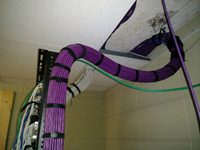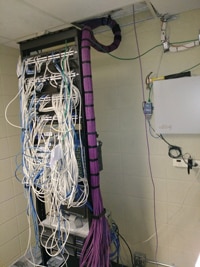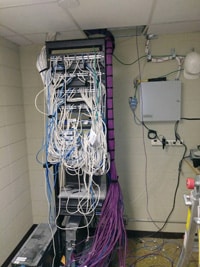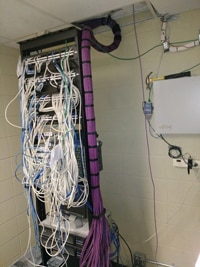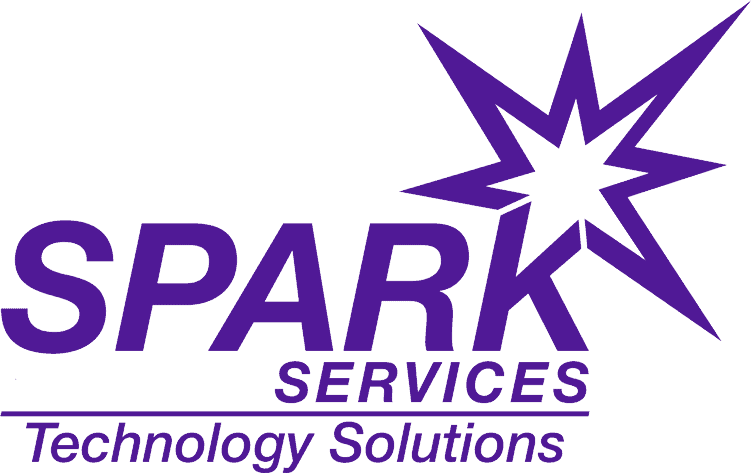Structured Cabling Services
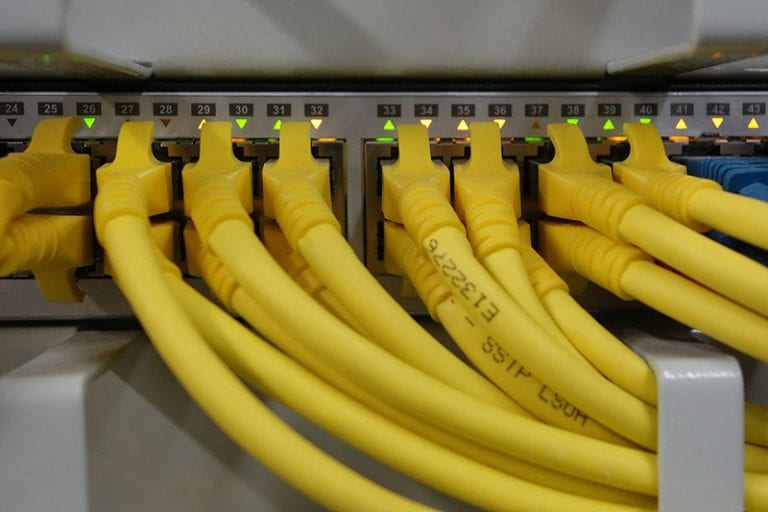
SPARK Services is proud to offer our customers the best-in-class cabling services for all your needs.
Whether you are designing a new network or upgrading your current system, there are several elements to consider in order to assure the best return on investment.
Additional research in the beginning from our professionals can translate to extraordinary long-term savings, in terms of time and money.
A well-designed network can pay dividends for years to come.
Why Should You Want a Professional?
As a professional, structured network cabler, we will have the specs on how to most effectively make your connection to a larger network. Depending on the sort of data system you require, different sorts of cables may be applied to create the best network for your location.
Imagine getting a new desk lamp for your office. You are eager to try it out, but instead of simply plugging it into a nearby power outlet, you have to run an extension cord down to the basement to the breaker panel. And then you have to do the same thing for a new printer or any other gadget requiring power. Early networks were connected much the same way, with patch cords, before structured cabling and its complementary standards were developed. To obtain high performance in different cable deployments, a structured cable system is important. Generally, it consists of cabling and connectivity products that integrate the voice, data, video, and various management systems of a building. Hospital campuses, data centers, and various other institutions that integrate the qualities of a great structured cabling system are all set for reconfiguration and expansion.
What is Structured Cabling?
Structured cabling is a kind of infrastructure that supports the performance of an organization’s cabling system or network. It is the glue that binds all phones, computers, and other devices used within the business premises together, offering a reliable and versatile solution to a wide range of communication requirements. Of course, the importance of organized cabling systems varies from business to business. Still, it leads to a highly reliable and cost-effective network infrastructure that stands the test of time for the majority.
Simply put, structured cabling is a cabling infrastructure that offers an organized approach to cabling that allows simple changes to any network.
Every structured cabling system is innovative. This is due to variations in:
- The kind of equipment the cabling installation will support
- Manufacturer warranties
- Cable and connection products
- Consumer requirements
- Function of the cabling installation
- Architectural structure of the building, that has the cabling installation
- Configuration of a previously installed system
There are two standards for the same as well. These standards define the design, build, and cabling system’s structuring. There are seven components that form a structured cabling system, and they are:
- Backbone cabling: This is also known as vertical cabling. It generally ensures connectivity between telecommunication rooms, equipment rooms, access provider spaces, and entrance facilities. They typically exist on the same floor. This cabling can support many diverse user applications, from simple voice transmission to high-speed data and multimedia networks.
- Horizontal cabling: The horizontal cabling is all the cabling between the telecommunications outlet in a work area and the horizontal cross-connect in the telecommunications closet, including horizontal cable, mechanical terminations, jumpers and patch cords located in the telecommunications room or telecommunications enclosure, multiuser telecommunications outlet assemblies and consolidation points. This typically runs horizontally in the ceilings or the floors in a building.
- Equipment room: This is the centralized space where the equipment inside a building is housed. The telecommunication systems like the servers, switches, and the mechanical terminations of the wiring system are present. This has more complicated equipment as compared to the telecommunications closet. Cabling from the entrance facility runs into the equipment room through a patch panel. It is vital to secure the equipment room and any kind of area that stores telecommunications equipment or network hardware.
- Work area: This is the part where cable components are used between communication outlets and end-user telecommunications equipment. It often includes station equipment, patch cables, and communication outlets. Telephones, computers, etc. are all included here. Work area components are what connect the end user’s equipment to the outlets in the horizontal cabling subsystem.
- Telecommunications Closet (Room and Enclosure): This is essentially an enclosed area like a room or a cabinet where the telecommunication equipment, distribution frames, cable terminations, and cross-connects are housed. It is important that each building should have at least one wiring closet which generally depends on the size of the service area.
- Entrance facility: This encloses the cables, network demarcation points, and connecting hardware. It protects the devices and all the other equipment that acts as an access provider.
- Patch cables: Along with standard horizontal and backbone cabling, there is another kind of cable that is used within a structured network cabling system and that is patch cables or cords. These are the cords that connect between the horizontal cabling and the different network devices and outlets such as the wall plate connectors. They need to be flexible enough to withstand frequent connecting and reconnecting, so are therefore made with stranded conductors, rather than the solid copper that a standard cable consists of. They are usually no longer than 2 m and come in a variety of diverse colors to make them easily visible.
What does Structured Cabling offer?
– It supports equipment and applications of many vendors, not just a single vendor.
– It has a consistent and uniform design. It follows the system plan and basic design principles.
– It uses standard connection interfaces for the physical connection of equipment.
– It is designed and installed as a total system, removing the need to install cabling on an as-needed basis.
Structured cabling systems include all the wires, cables, and associated equipment and apparatus essential to offer service from the network interface to the information outlet at the work location or any other communication device within the customer premise.
7 Ways Structure Cabling Can Provide A Business Advantage
1. Highly Economical
Incorporating a structured data cabling solution will prove to be a highly economical alternative for your company as not only is it extremely flexible but it also has the capacity to take on all the taxing demands that your business might make on it.
2. Extremely Easy and Uncomplicated
Not only is a structured cabling system extremely efficient and organized, but it is also very easy and uncomplicated. This is because having one properly organized system to run IT equipment and various other devices is a lot simpler and easier to manage than having numerous wiring systems installed. Additionally, a precisely engineered and installed structured cabling system will require little maintenance, freeing up staff to work on applications and projects.
3. Structured Cabling is Easy to Scale
Owing to how tidily they’re organized and packed away, structured cabling is super easy to scale, which is a big blessing when you need to include new technology or machines to your IT infrastructure.
The design consistency decreases management oversight. Any certified structured cabling installer can come in, any time in the future, and undertake adjustments to the network. This way you’ll fetch uniform documentation.
4. Higher Aesthetic Appeal
Neat and tidy is the way to go in order to maintain the aesthetic appeal of your office environment. Not to mention, there is nothing like a neat and organized office to make a good impression on your clients. No mess, no stress!
5. Speedy Redressal & Resolution of Issues
Incorporating a structured cabling system in your office workspace or place of business is a great way of ensuring that all the incidental technological problems that might crop up in the future can be addressed and resolved quickly and efficiently, without having to waste too much time.
6. Works with the Internet of Things
The connection of any device, such as a smartphone or a smart car to the internet is referred to as the Internet of Things. As the usage of IoT-enabled devices is becoming increasingly prevalent, it only makes sense to get a structured cabling infrastructure that can be seamlessly integrated with IoT in order to enjoy better cyber-security and energy management. This also helps with the automation of important business operations.
7. Support Application & Equipment
With modern structured cabling systems, what used to be tedious, confusing and in some situations an ugly eyesore can be transformed into a showcase of organization and a valuable asset. If your business goes through a rapid growth and adds applications such as audio-video enhancements or video conferencing, it can be simply done with minimal interruptions. Structured cabling systems are adaptable and scalable to the growing needs of business. New technologies can be easily and cost-effectively added.
The major key to structured cabling is that it places your business to take on the challenges of an emerging era of telecommunications. Are you looking to incorporate a structured cabling system in your office space or place of business? Well, look no further. SPARK Services is here to help you with all your computer, web, and voice needs. Here at SPARK Services, for instance, our installers work with customers to adapt the design so it fits the site’s architecture and the network’s purpose.
We reconfigure it to suit the kinds of end-use equipment destined for that space. We also take into account the particular requirements suggested by the clients as well as the manufacturer’s guidelines and warranties of each product. Reach out to us today for any web concerns and queries you might have. We always leave room for future growth and expansion. In the end, each area has a unique cabled network designed to take its business into the future – wherever that future may lead.
Advantages of a Structured Cabling System
A structured cabling system has lots of advantages. First, it helps regulate the cabling system, making future handling of troubleshooting easier. In this way, one can avoid reworking the cabling while upgrading to another vendor or model, which extends the lifespan of any equipment.
Time-Saving
Port and cable tracing become more straightforward with a structured cabling system. This logical and organized approach makes changes more manageable and saves time.
Clean Look
A structured cabling system looks much cleaner than a point-to-point method. This allows the cabling to appear neat and clean in front of the switch.
Enhanced Flexibility
Structured cabling systems offer enhanced levels of flexibility, helping to advance performance and drive business growth. It helps to accommodate moves quickly, adds, and changes, reducing installation time and ensuring optimum adaptability to any network infrastructure changes. The flexibility also makes the system easy to take apart and move to a new office location.
Adaptability
Structured cabling systems come with high bandwidth. With this, the system can support future applications introduced to the business, i.e., video conferencing or multimedia, without any interruptions. This ensures that the cabling system never gets outdated in the future.
Fewer Management Oversights
The design consistencies of the structure decrease management oversight. Any certified structured cabling installer can come in any time in the future and make changes to the network. The installers understand where to begin and figure out the basic configuration of the system.
Benefits of a Structured Cabling System
A structured cabling system has many benefits. It helps to standardize your cabling system, and future handling of troubleshooting will be easier. In this way, you can avoid reworking the cabling when upgrading to another vendor or model, which prolongs the lifespan of your equipment.
From connecting your business with voice and web services, to repairing broken laptops and smartphones, SPARK Services specializes in improving the technology that enhances you and/or your business. Our team works hard to provide you with the very best in it, networking, web design, and computer related services, with a focus on dependability, customer service, honesty, and trust.
The Importance of Structured Cabling During a Crisis
The advantages of using a structured network infrastructure include lower material and labor costs, single point of contact for systems integration, single installation force for cabling, reduction in physical space requirements, reduced maintenance and administration costs, and the ability to migrate to new technologies with greater ease, lower costs, and less risk. Today, with energy conservation becoming a global priority and the need to add capacity to data centers quickly, the workforce shift to a “work from home” model has never been more critical. In addition, with properly structured network infrastructure, the merging of computers, telephones, wireless devices, and building management controls onto one centralized IP network is enabled as the technology evolves and improves the building’s carbon footprint.
Your business network is the lifeblood of your company, and it’s under stress like never before. It’s too crucial to trust structured cabling solutions. SPARK Services offers the best-structured cabling solutions and continues to set the standards before the industry can publish the standards.
We at SPARK Services connect your network from the data center to the desktop and everywhere in between. As a professional cabler, we offer the specs on how to transfer your connection to a more extensive network most effectively. With SPARK Services as your partner, you can be assured that your network will benefit from industry-leading expertise and best-in-class support at each stage.
How Structured Cabling Can Help Your Business
Rapid growth of your business generally means that it is time to upgrade your structured cabling as well. Business owners add pieces of network hardware, generally by different manufacturers and of different quality, and this tends to hamper the efficiency of the system. After some time, it will not matter how many upgrades you have. If that stage ever comes, it is time for you to revamp your entire system.
We at SPARK Services are here to help you plan that restructuring and support all the structured cabling needs of your company. Here are 5 steps you need to plan before an upgrade!
Implementing A Structured Cabling Strategy
1. Conduct a site survey
A site survey will give you an idea of the existing system in your building which serves as a starting point for the project. A survey typically entails: determination of the number and types of equipment needed for specific wired/ wireless operations, figure out the existing configurations, locate the physical network infrastructure, create an accurate floor plan to be used as a reference during the upgrade process and map out a logical topology to show the path that data takes through the network and the locations where the functions such as routing occur.
2. Document current and future network requirements
After an interview with you and your staff, the network designer will determine your existing network requirements. Information from all parts of the company and workers will help to accurately map the needs of your company. Here are some of the things your network designer will need to know:
- The present number of network uses and an approximate number of how many are to be added in the next 12 months
- What applications the current system supports (such as VoIP or video conferencing)
- What new services are needed, if there are any services your current system already does not support
3. Making a report after the interview
With the information obtained, from your staff and site workers, your network designer will create an analysis report and give it to you. This is to ensure that no facts are missing and that the technician has made no error in assessing your system and in turn not make any mistakes for your future needs. Once you give your approval on the report, the upgrading process can officially begin.
4. Select the device and cabling
The selection process is about evaluating your cost and performance needs. The cabling that can be chosen includes copper cabling, coaxial cabling, and fiber optic cabling. All these come in different sizes and variations.
5. Installation, testing, and review
If all the plans and reports are made perfectly, the installation should go smoothly. This is the time to make corrections if any. When this is complete, the goals have been achieved. Once your review is received, that is when the job is considered to be done.
To know more, connect with us today itself!
